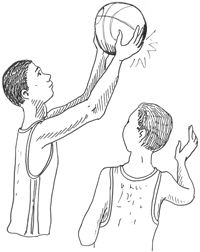STRANGE BUT TRUE- Pinkie fingers: How to tell if a shot will drop

DRAWING BY DEBORAH DERR McCLINTOCK
Q. In pro basketball, who makes use of the amazing "pinkie finger" prognosis?–R.Sampson
A. Elite players often do, even if unconsciously. As reported in Nature Neuroscience, University of Rome neuroscientist Salvatore Anglioti et al used video clips of shots to study exactly when coaches, players, and fans could tell if a shot was going to swish through the net or bounce off the rim. They found that all three groups did better the longer the clip was and the closer to the basket they could track the ball.
Here's the amazing part: Savvy players could predict success about 70 percent of the time, even when the clips were cut off at a point before the shooter released the ball. That compared to only 40 percent for "expert" spectators such as coaches and sportwriters.
The players were able to do this presumably because they had become seasoned readers of body language, including especially how the pinkie finger was held just as the ball was being released, affecting the ball's spin and likelihood of a basket. Thus, in effect, the pros' secret seems to be an ability to play the shot mentally and get ready for a rebound (or whatever) just by watching the shooter's body.
Q. Maybe it took half a millennium for humankind to do right by the memory of the great Nicolaus Copernicus but finally we did. How so?–G. Galilei
A. The Polish scientist, "the man who moved the Earth" with the idea that our planet orbits the sun rather than the reverse, died in 1543 and was buried in an unmarked grave. In 2005, archaeologists used church records and ground-penetrating radar to unearth a skeleton from under a medieval cathedral in Frombork, Poland. Its age matched the 70-year-old Copernicus. Analysis of the bones and a reconstruction of the face supported the identification, but without DNA evidence, nobody could be sure because the Catholic priest had left no known heirs.
"He did leave hairs, however," reported Constance Holden in Science magazine. Swedish researchers found several nestled in the binding of one of his well-thumbed standard astronomical references at the University of Uppsala. When genealogist Marie Allen extracted mitochondrial DNA (mtDNA) from the badly degraded hairs and compared it with mtDNA from the skeleton's tooth, she announced a match. Now plans are to rebury Copernicus' bones in Frombork in 2010 and to mark the site honorably and historically at last.
You don't have to leave heirs– just hairs.
Q. It strikes without warning and can jangle the nerves of even seasoned air travelers but maybe not for much longer. What's CAT got to do with this?–F. Laker
A. "Clear air turbulence" is far less predictable than turbulence caused by storms, high winds, or the flow of air over mountains, says Paul Williams of the University of Reading, UK, in New Scientist magazine. Since with CAT the skies are clear and blue, pilots can't easily avoid the problems, so hundreds of passenger injuries occur every year.
The current warning system, or Graphical Turbulence Guidance, relies on pilot reports and observations and is not very accurate. A new model uses wind-speed measurements to pinpoint the cause of the turbulence, which is gravity waves generated at the boundaries between fast-moving high-altitude jet streams and slower-moving air. Now pilots can predict better where these waves are likely to be strongest and can skirt any trouble.
In one study, the new setup successfully predicted 83 percent of incidents, raising hopes of "declawing" CAT even further.
Q. Can a chimpanzee apply Euclid's definition that a straight line is "the shortest distance between two points"?-J. Goodall
A. To test "cognitive maps" in nonhuman primates, researcher Emil Menzel carried a chimp around with him while hiding food in 18 locations on a large field, in clumps of grass or behind other natural cover, says John P. Dworetzky in Psychology.
Then the chimp was returned to the starting point and released along with five other chimps that had not observed the food placement. As you might guess, it was the first chimp that found almost all the food. He even knew to take "Euclidean shortcuts" across parts of the field he hadn't been in, not just mechanically retracing steps.
He didn't have a perfect score, however. But this set the researchers to laughing because when they went to find the missing food, they too had forgotten where it was.
~
Send strange questions to brothers Bill and Rich at [email protected].
#